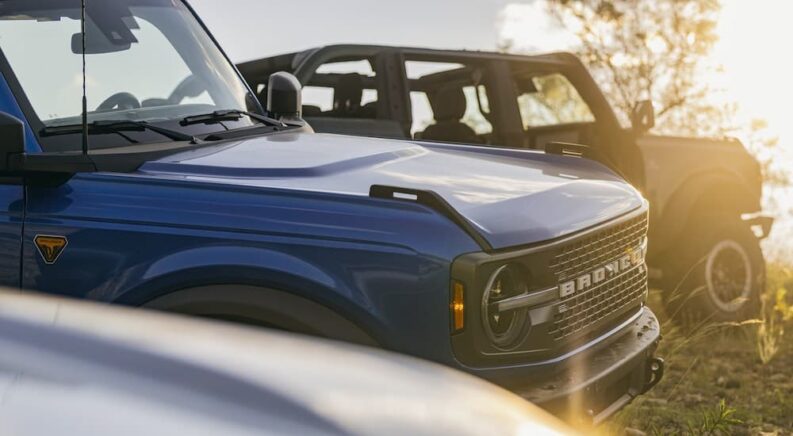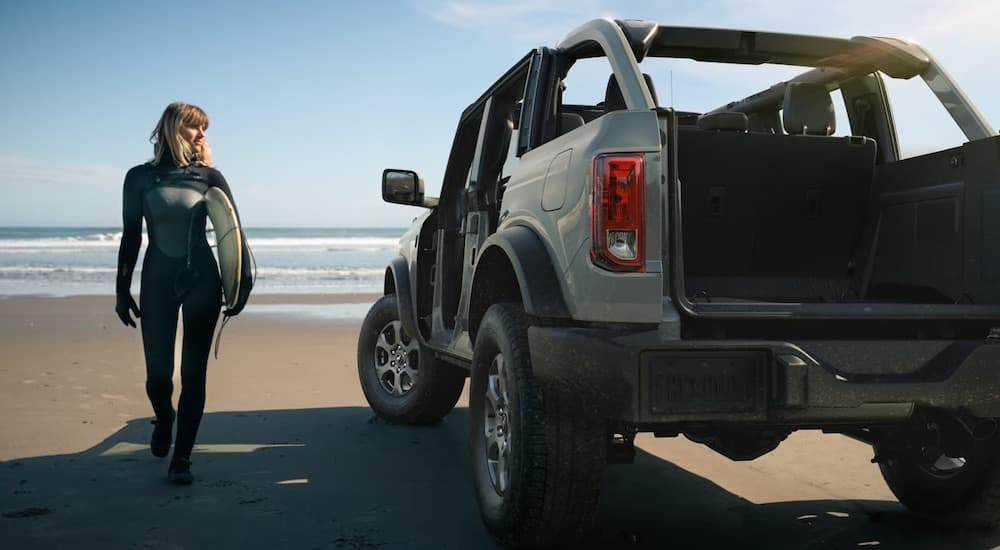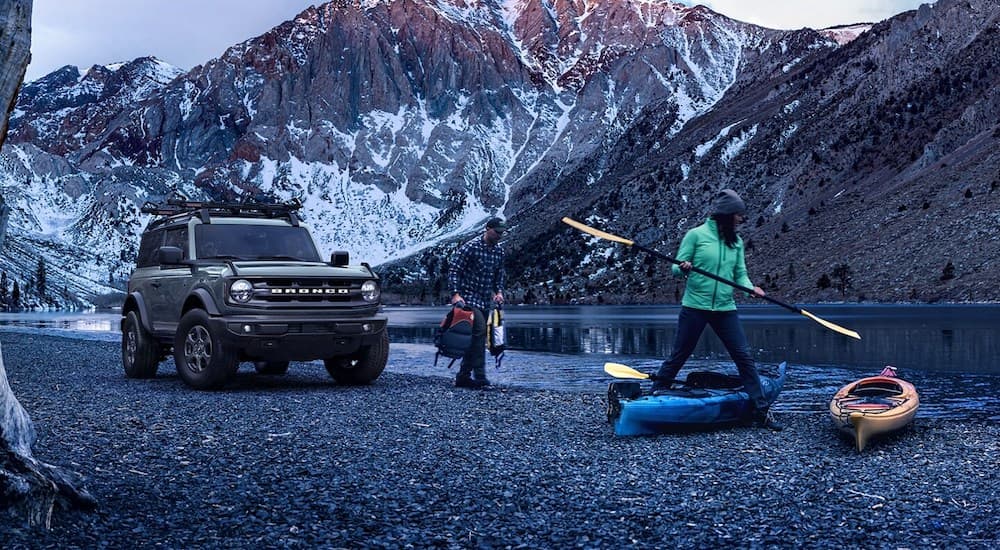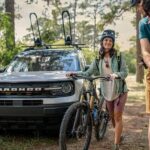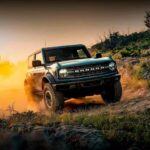If you’re in the market for a new SUV, a quick visit to your local Ford dealership should turn up a full slate of intriguing options. From the compact Ford Escape and Bronco Sport to the midsize Edge, Ford’s crossover SUVs have proved to be some of the brand’s most popular models in recent years. Well-rounded, reliable, and perfect for the family on the go, these models have gone a long way in satisfying the public’s insatiable appetite for crossover SUVs. But why settle for a vehicle designed for paved roads when there are so many off-road-ready models currently on the market?
The typical driver might rarely find themselves recreating the rock-crawling, creek-fording antics common to so many car commercials, but a little off-road utility can go a long way, especially for those living in rural areas or regions that experience harsh winter weather. There’s only one problem. As the popularity of these rough-and-tumble trims continues to rise, it seems like automakers have started throwing the off-road badge on any vehicle with four-wheel drive and half-decent ground clearance. There’s nothing wrong with this new generation of so-called “soft-roaders,” but it takes more than some upsized wheels, roof rails, and a name like Trailsport or Timberline to ensure off-road success. What should a driver look for when shopping for an off-road SUV? To put it briefly: a Ford Bronco for sale. Unlike its crossover counterpart in the Bronco Sport, the revived Ford Bronco employs traditional body-on-frame construction to deliver consistent, safe off-road performance.
Due to their unibody construction, crossover SUVs simply can’t tolerate the flexing and torque that comes with heavy-duty off-road use. Body-on-frame SUVs, on the other hand, are designed to take whatever you can throw at them with a robust body that can withstand the rigors of bumpy, uneven off-road terrain without sustaining any long-term damage. The Ford Bronco burst back onto the scene in 2021 after a 25-year absence, giving drivers a bold new off-roader that leverages the original Bronco’s iconic design to deliver a one-of-a-kind SUV that’s ready to get wild. Of course, the Ford Bronco isn’t the only midsize, body-on-frame SUV with off-road chops. Join us as we take a closer look at the 2024 Ford Bronco and compare it against one of its main competitors in the 2024 Jeep Wrangler.
Engines
When navigating paved roads, an underpowered engine is usually little more than a nuisance, but it can quickly escalate into a deal breaker if you’re the type of driver who enjoys a little off-road fun. Decent horsepower is important, but so is torque, which dictates how well your vehicle can accelerate from a dead stop and pull itself over obstacles like boulders, fallen trees, and the like. How do the 2024 Ford Bronco and 2024 Jeep Wrangler compare when it comes to what’s under the hood?
The Ford Bronco’s standard engine is a turbocharged 2.3L EcoBoost Turbo I-4, which makes 300 horsepower and 325 lb-ft of torque. While the entry-level engine might be a little light in the torque department, it’s also the most efficient of the bunch, with an EPA-estimated 20 MPG in the city and 21 on the highway. This makes the four-cylinder EcoBoost the ideal choice for budget-conscious drivers who will be mostly keeping their Bronco sad
dled to the road. For our money, the optional 2.7L EcoBoost Turbo V6 represents the sweet spot when it comes to power and price, giving drivers 330 horsepower and 415 lb-ft of torque to play with.
The Bronco lacks a V8 option, but those who spring for the desert racing-inspired Bronco Raptor probably won’t be disappointed with the SUV’s 3.0L EcoBoost Turbo V6 that puts out 418 horsepower and 440 lb-ft of torque. It’s a thirsty little beast at 15 MPG in the city and 16 on the highway, but that’s why it’s always important to pack a few extra jerrycans of gas. All three Bronco engines come standard with a 10-speed automatic transmission, with a seven-speed manual being limited to the four-cylinder version.
The Wrangler comes standard with a 3.6L Pentastar V6, which doesn’t quite keep up with the Bronco at 285 horsepower and 260 lb-ft torque. An engine stop/start feature allows the V6 to post a respectable 20 MPG in the city and 23 MPG highway, but again, power is lacking. The optional 2.0L Turbo I-4 engine makes 270 horsepower, even less than the V6, but more torque at 295 lb-ft, still less than the Bronco’s standard Turbo I-4. The engine is surprisingly efficient for an off-roader, however, giving drivers 22 MPG city and 24 MPG highway, but the sub-300 horsepower is a little underwhelming, to say the least.
The range-topping Wrangler Rubicon 392 makes up for its underpowered cousins, with a 6.4L HEMI V8 that puts out a nice, symmetrical 470 horsepower and 470 lb-ft of torque. It’ll cost you both at the pump, though, with 13 MPG city and 16 MPG highway, not to mention a starting price over $91,000. While the Wrangler is also offered as a plug-in hybrid (PHEV) that pairs a 375 horsepower, 2.0L I-4 engine with an electric motor, we’re going to ignore that option for now, as off-road trails tend to lack convenient charging stations. That said, the PHEV version of the Wrangler is by far the most fuel-efficient of the bunch, with an EPA-estimated 49 MPGe.
Four-Wheel Drive
Four-wheel drive (4WD) is the bread and butter of the off-road segment. No matter how rugged an SUV might look, it’s liable to end up mired in the first patch of mud, snow, or sand it comes across if you’re only pulling with two wheels. Unsurprisingly, both the 2024 Ford Bronco and 2024 Jeep Wrangler both come with 4WD as standard equipment, but there are still a few choices that a driver needs to make when it comes to choosing between offerings.
We’ll begin with the Bronco, which comes with two distinct 4WD options. The base system is a part-time 4WD setup that’s built around a two-speed transfer case with three different selections for increasingly difficult conditions: 2-Hi, 4-Hi, and 4-Lo. Ideal for snowy, icy, or off-road conditions, this system is the more traditional of the two 4WD options on the table for 2024. If you’re looking for a 4WD system that better mimics the seamless experience of all-wheel drive (AWD), the Bronco’s second offering is worth a closer look. This 4WD system adds a 4-Auto mode that acts like a typical AWD system. It runs in a more efficient, two-wheel drive setup until slippage is detected, at which point the front axle kicks in to lend a helping hand. If you want to keep the system in 4WD mode at all times, it’s as easy as selecting the 4-Hi or 4-Lo setting. The decision to go with the part-time or on-demand 4WD system largely comes down to a matter of preference, though the latter is probably the better option if you’re looking to reduce distractions while navigating difficult off-road terrain.
The 2024 Jeep Wrangler comes with three 4WD systems to choose from, starting with Command-Trac. Basically identical to the Bronco’s base 4WD system, Command-Trac features a part-time transfer case with 2-Hi, 4-Hi, and 4-Lo modes. The system’s real selling point is its impressive 2.72:1 crawl ratio when in 4-Lo, which can come in handy when you’re trying to ascend steep inclines or navigate tricky obstacles. Jeep’s Selec-Trac system adds a 4-Auto mode much like the Bronco, but the Jeep also has a third option to choose from, its Rock-Trac system. Limited to the Wrangler’s Rubicon trim, this version boasts a 4.0:1 crawl ratio in 4-Lo, which can deliver the same results as an off-roader that’s geared 100:1 when paired with the right optional equipment packages.
Suspension
A heavy-duty suspension might not seem as important as 4WD or a powerful engine, but you can’t log too many miles on the trail if your off-roader is tossing you around the cabin every time you hit a bump. In addition to the comfort-related advantages, a good suspension also improves handling and is vitally important when it comes to absorbing the damaging bumps and shocks that can come with challenging off-road driving. Bottoming out your vehicle on a speed bump at your local supermarket is one thing, but hitting a big rock on the trail can be a whole different ball game if it occurs miles off the grid.
The Bronco’s suspension is based around a proprietary Ford design known as the High-Speed Off-Road Suspension System (HOSS). The system comes in three ascending levels of functionality, HOSS 1.0, 2.0, and 3.0, which rises to four if you count the Bronco Raptor’s HOSS 4.0. Standard on the Outer Banks and Black Diamond trims, HOSS 1.0 includes twin forged alloy A-arms with long-travel coil-over springs, Hoss-tuned heavy-duty dampers, and a 220-mm solid rear axle with long-travel, variable-rate coil-over springs. Choosing the Badlands, Everglades, Heritage, or Heritage Limited Edition (or any trim with the optional Sasquatch package) will land you HOSS 2.0, which combines Hoss-tuned Bilstein position-sensitive dampers with end-stop control, an independent front suspension, and end-cap control valves designed to improve handling and ride comfort. The position-sensitive damper is one of the more notable upgrades as it allows the system to better respond to changing terrain, using a softer damping force for on-road driving and a stronger damping force when the going gets rough.
Reserved for the Wildtrak trim, HOSS 3.0 nixes the conventional passive damping system found on the 1.0 and 2.0 versions with Live Valve 3.1 internal-bypass semi-active dampers. These dampers are better able to account for shaft velocity and position, resulting in a smoother ride for all involved. The automaker has also raided its Ford Performance department to give the HOSS 3.0-equipped Broncos a severe-duty steering rack and tie rod ends, which improve the SUV’s maximum load by an impressive 40 percent.
When it comes to the suspension, the Jeep is a little underwhelming in comparison. That’s not to say Jeep’s suspension system doesn’t get the job done. There’s a reason the brand’s name has basically become a byword for off-road performance. But the Wrangler lacks the customization potential of the HOSS system, leaving the aftermarket to fill in the gaps. The Bronco’s independent front suspension is a major upgrade over the Jeep’s front stick axle, but the 2024 Wrangler still soaks up most of the bumps in the road thanks to a traditional five-link coil suspension setup.
Designed with two upper and lower high-strength steel control arms and a cross-car track bar to stabilize things laterally, the front suspension does an admirable job of reducing the fatigue that can come with a long day on the trail. The rear suspension combines a five-link design with two upper and lower control arms and a track bar, providing a comfortable ride both on-road and off. The Wrangler Rubicon gets an additional electronic front sway-bar disconnect feature, which allows for additional wheel travel in situations where maximizing traction is key.
And the Winner Is…
Finding the right tool for the job can make all the difference. When properly outfitted with a well-rounded SUV like the Ford Bronco, off-roading can be some of the most fun you’ll ever have behind the wheel, allowing you to explore far-flung locales, hone your driving skills, and test your mettle against the challenges of the trail. Between its selection of powerful, torque-rich engines, brawny HOSS suspensions, and two 4WD offerings that combine the best aspects of all-wheel- and four-wheel drive systems, the 2024 Ford Bronco looks just as ready to roam the open plains as its equine namesake. The 2024 Wrangler is another strong showing from Jeep, but it struggles to keep up with the Bronco in a few key departments. To some degree, that’s to be expected. The Jeep brand is always going to have its die-hard fans who will keep trading in for a new Wrangler every couple of years, but in trying to make a name for itself upon its return to the market, the Bronco simply seems to be putting in a little more effort.

